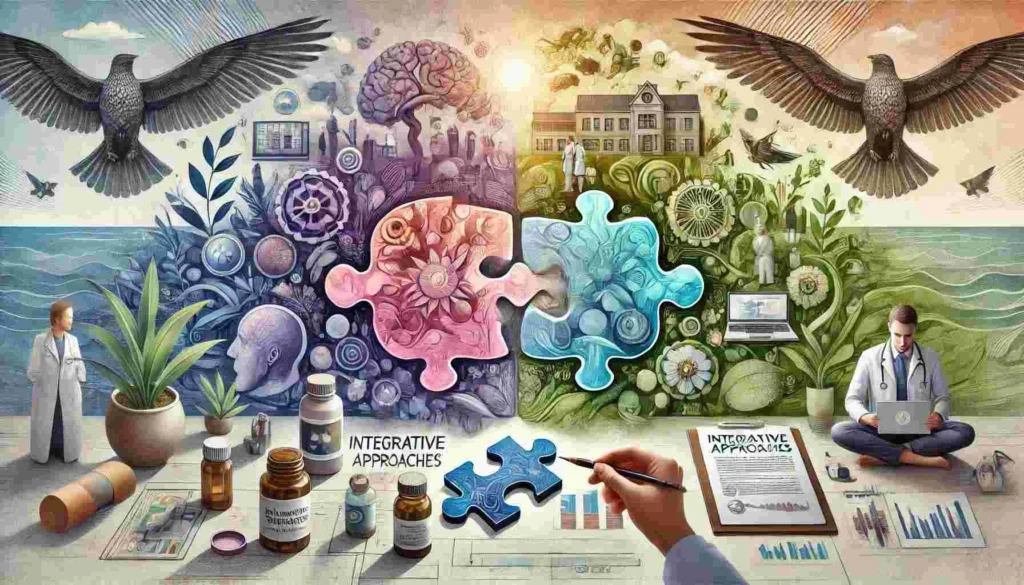
Integrative Approaches to Mental Health: Combining Therapies for Optimal Results
Introduction
Mental health is a cornerstone of overall well-being, influencing how individuals think, feel, and interact with others. Traditional therapies like medication or talk therapy have proven effective for many, but integrative approaches are gaining recognition as a powerful way to achieve optimal mental health outcomes. Combining therapies can provide a holistic approach that addresses both the symptoms and underlying causes of mental health issues.
This guide delves into integrative mental health strategies, explaining how combining various therapies can offer comprehensive care, improve resilience, and foster emotional balance.
Understanding Integrative Mental Health
What Is Integrative Mental Health?
Integrative mental health refers to the use of multiple therapeutic approaches to treat psychological and emotional conditions. It blends conventional methods like medication and psychotherapy with complementary and alternative therapies such as mindfulness, nutrition, and yoga. The goal is to support the mind and body simultaneously for holistic healing.
Why Integrative Approaches Matter
Traditional methods often focus on addressing specific symptoms. For instance, antidepressants target chemical imbalances, while cognitive behavioral therapy (CBT) tackles negative thought patterns. Integrative approaches consider the individual as a whole, combining these targeted treatments with lifestyle changes, physical health considerations, and alternative methods to provide comprehensive care.
Benefits of Combining Therapies
1. Tailored Care for the Individual
Integrative approaches recognize that no two individuals are the same. For example, someone with depression may benefit from medication combined with mindfulness exercises, while another might respond better to a mix of CBT and nutritional therapy. Personalizing treatment plans ensures higher effectiveness.
2. Addressing Root Causes
Mental health issues often stem from a mix of biological, psychological, and social factors. Combining therapies allows practitioners to address underlying causes, such as chronic stress or nutritional deficiencies, alongside immediate symptoms.
3. Holistic Well-Being
Integrative therapies emphasize the connection between the mind and body. Practices like yoga, meditation, and acupuncture can complement traditional treatments by reducing stress, improving sleep, and enhancing emotional resilience.
Key Therapies in Integrative Mental Health
1. Psychotherapy
Psychotherapy remains a cornerstone of mental health treatment. Modalities like CBT, dialectical behavior therapy (DBT), and psychodynamic therapy help individuals process emotions, change behaviors, and develop coping mechanisms.
2. Medication
For many conditions, such as severe anxiety or bipolar disorder, medication can be life-saving. Antidepressants, mood stabilizers, and anti-anxiety drugs are often used in combination with other therapies for the best results.
3. Mindfulness and Meditation
Mindfulness practices like meditation are powerful tools for reducing stress and anxiety. Studies show that regular meditation can rewire the brain, improving emotional regulation and focus. Combining these practices with psychotherapy enhances their impact.
4. Nutrition and Mental Health
The connection between diet and mental health is undeniable. Nutritional deficiencies in vitamins like B12, omega-3 fatty acids, and magnesium can contribute to mood disorders. Integrating nutritional therapy ensures the brain has the resources it needs to function optimally.
5. Exercise and Physical Activity
Exercise is a natural mood booster. Activities like walking, swimming, or yoga release endorphins, reduce stress hormones, and improve sleep. Combining exercise with psychotherapy or medication can amplify mental health benefits.
The Role of Alternative Therapies
1. Acupuncture
Acupuncture, an ancient Chinese practice, is increasingly used in mental health care. It can help alleviate anxiety, depression, and insomnia by balancing the body’s energy flow.
2. Art and Music Therapy
Creative therapies like art and music provide non-verbal outlets for emotions. They are especially beneficial for individuals who find it challenging to express themselves through traditional talk therapy.
3. Aromatherapy
Using essential oils like lavender or chamomile can promote relaxation and reduce stress. While not a standalone treatment, aromatherapy complements other therapies effectively.
Practical Applications of Integrative Mental Health
How to Combine Therapies Effectively
Creating a personalized integrative mental health plan requires collaboration between the individual and healthcare providers. Each therapy should complement the others, addressing physical, emotional, and psychological needs cohesively.
1. Start with a Comprehensive Assessment
Before embarking on an integrative approach, a thorough mental health assessment is essential. This includes identifying symptoms, triggers, and underlying factors such as diet, lifestyle, and genetic predispositions.
- Physical Health Check: Blood tests can reveal deficiencies in key nutrients like vitamin D or iron, which impact mood.
- Emotional Well-Being Evaluation: Tools like mood journals or self-assessment surveys help understand emotional patterns.
- Lifestyle Analysis: Examining sleep habits, exercise routines, and daily stressors provides insight into areas for improvement.
2. Crafting a Multidimensional Treatment Plan
An effective plan combines therapies in a way that maximizes their benefits. For example:
- Primary Treatment: Psychotherapy or medication to manage acute symptoms.
- Supportive Therapies: Mindfulness practices and exercise to reduce stress and promote resilience.
- Nutritional Support: Supplements or dietary adjustments to optimize brain health.
3. Monitoring Progress and Adjusting Treatments
Integrative approaches require ongoing monitoring to ensure therapies remain effective. Regular check-ins with healthcare providers allow adjustments based on progress or emerging needs.
Challenges in Adopting Integrative Therapies
While the benefits of combining therapies are significant, there are challenges to consider:
1. Accessibility and Cost
Some integrative therapies, like acupuncture or nutritional counseling, may not be covered by insurance. This can make them less accessible to those with limited financial resources.
2. Finding Qualified Practitioners
Not all practitioners are trained in integrative methods. It’s crucial to find professionals experienced in combining traditional and alternative therapies.
3. Time Commitment
Integrative approaches often require a significant time investment. Regular therapy sessions, mindfulness practices, and physical activities demand consistent effort.
4. Potential Overlap or Interference
Certain therapies might interfere with each other if not managed properly. For instance, some medications may not align with specific nutritional supplements or alternative treatments.
Overcoming Challenges
- Research and Planning: Learn about the therapies and their practitioners before committing.
- Financial Aid: Explore community programs or sliding-scale fees for alternative therapies.
- Communication: Ensure all healthcare providers involved are aware of the full treatment plan to avoid overlaps or conflicts.
Success Stories and Case Studies
Case Study 1: Overcoming Anxiety with CBT and Mindfulness
Sarah, a 34-year-old professional, struggled with chronic anxiety. Traditional therapy helped her identify triggers, but she still faced daily stress. Integrating mindfulness meditation with CBT provided her with tools to manage her thoughts while staying grounded. After six months, Sarah reported significant reductions in anxiety and improved focus.
Case Study 2: Depression Managed with Medication and Nutrition
James, a 40-year-old teacher, experienced severe depression that made it hard to function. While antidepressants stabilized his mood, incorporating a nutrient-rich diet with omega-3 supplements boosted his energy and emotional balance. Together, these approaches allowed James to regain control of his life.
Case Study 3: Trauma Recovery with Yoga and Talk Therapy
Linda, a 28-year-old trauma survivor, found traditional talk therapy beneficial but emotionally draining. Adding yoga to her routine provided a safe space to reconnect with her body and manage stress. This combination facilitated deeper healing over time.
Real-World Integration: Step-by-Step
1. Focus on Small Changes First
For individuals new to integrative approaches, starting small is key. Introducing a single new therapy—like guided meditation or light exercise—can make the process more manageable.
2. Build a Support System
Combining therapies often works best with support from loved ones or support groups. Sharing goals and progress fosters accountability and encouragement.
3. Leverage Technology
Apps for mindfulness, exercise tracking, and mood journaling can complement therapies. Digital tools also make it easier to stick to routines.
4. Prioritize Consistency
Integrative approaches require regular effort. Whether it’s attending therapy, practicing mindfulness, or maintaining a balanced diet, consistency is critical for success.
The Future of Integrative Mental Health
Emerging Trends in Integrative Mental Health Care
As awareness about mental health continues to grow, innovative practices are reshaping how therapies are combined to create impactful outcomes. The integration of technology, personalized medicine, and new therapeutic approaches is paving the way for a brighter future in mental health care.
Technology’s Role in Integrative Therapies
1. Telemedicine and Online Therapy
The rise of telemedicine has made mental health services more accessible. Online therapy platforms offer a convenient way to access psychotherapy, while apps provide guided mindfulness exercises and cognitive behavioral therapy tools.
- Benefits: Greater accessibility, reduced stigma, and flexible scheduling.
- Future Potential: Integration with wearable devices for real-time mental health monitoring.
2. Wearable Technology for Mental Health Tracking
Wearable devices like smartwatches now track more than steps—they measure sleep quality, stress levels, and even heart rate variability, which can indicate emotional states.
- How It Helps: Provides data-driven insights for both patients and healthcare providers.
- Example: Combining data from wearables with traditional therapy allows therapists to tailor sessions based on stress patterns.
3. Virtual Reality (VR) Therapy
Virtual reality is an emerging tool in mental health care, particularly for conditions like PTSD, phobias, and anxiety. VR exposure therapy helps individuals confront fears in a controlled environment.
- Complementary Use: Pairing VR therapy with mindfulness practices or traditional talk therapy enhances its effectiveness.
Personalized Medicine in Mental Health
1. Genetic Testing for Medication
Not all medications work the same way for everyone. Genetic testing can help identify how an individual’s body metabolizes certain drugs, ensuring the best fit for treatment.
- Benefits: Reduces trial-and-error in prescribing medication, leading to faster symptom relief.
- Integrative Application: Combining genetic insights with psychotherapy for a more targeted approach.
2. Nutritional Genomics
Emerging research shows that genetics can influence how the body responds to specific nutrients. Personalized nutrition plans based on genetic testing can help optimize brain function and emotional well-being.
- Example: Adjusting omega-3 intake for individuals with genetic markers linked to depression.
Expanding Alternative Therapies
1. Psychedelic-Assisted Therapy
Psychedelic compounds like psilocybin and ketamine are gaining traction in mental health care. Studies suggest they can alleviate treatment-resistant depression, PTSD, and anxiety when used under professional supervision.
- Integration: Psychedelics are often combined with psychotherapy for guided emotional processing.
- Caution: This approach is still emerging and requires strict regulation and professional oversight.
2. Biofeedback and Neurofeedback
These therapies use real-time data from the body to teach individuals how to control physiological functions like heart rate and brain activity.
- Biofeedback: Helps manage stress and anxiety by teaching relaxation techniques.
- Neurofeedback: Focuses on training brain wave patterns to improve mood and cognitive function.
- Complementary Use: Often combined with mindfulness and meditation for enhanced results.
Integrative Mental Health in Community Settings
1. Workplace Mental Health Programs
Organizations are increasingly adopting integrative approaches to support employee mental well-being. These programs combine traditional counseling services with wellness initiatives like yoga, mindfulness training, and stress management workshops.
- Impact: Reduces workplace burnout, boosts productivity, and fosters a supportive environment.
2. Schools and Youth Mental Health
Integrative mental health programs in schools help address issues like anxiety, depression, and bullying. Combining traditional counseling with art therapy, peer support groups, and mindfulness practices equips students with tools to manage their emotions.
- Example: A school may pair therapy sessions with extracurricular mindfulness activities to improve focus and emotional regulation.
Building Awareness and Accessibility
1. Reducing Stigma Around Mental Health
Despite growing awareness, stigma remains a barrier to seeking help. Integrative approaches that emphasize whole-body well-being can help normalize mental health care by framing it as a part of overall health.
2. Expanding Access to Care
Community health initiatives and public health campaigns can make integrative therapies more accessible, especially in underserved areas.
- Example: Free workshops on mindfulness or nutritional counseling in local community centers.
3. Leveraging Insurance and Policy Changes
Advocating for broader insurance coverage of alternative therapies like acupuncture, nutritional counseling, and mindfulness programs is crucial.
- Future Goal: Ensure integrative mental health care becomes a standard part of health plans.
The Promising Path Forward
1. A Holistic Paradigm Shift
The growing recognition of integrative mental health signifies a shift toward holistic care models that prioritize prevention and resilience over reactive treatment.
- Example: Early interventions that combine mindfulness, diet, and therapy can prevent mental health issues from escalating.
2. Collaboration Across Disciplines
The future of integrative mental health will likely involve closer collaboration between psychologists, nutritionists, fitness experts, and alternative therapy practitioners.
3. Empowering Individuals
Educating individuals about the benefits of integrative mental health care encourages proactive involvement in their well-being.
- Resources: Online courses, workshops, and support groups can teach individuals how to combine therapies effectively.



